
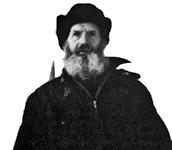
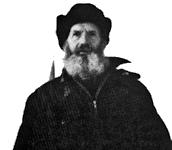
Much credit is due to the missionaries who came into the North long before my time, many of them by Red River cart. When in trouble, the natives always came to the priest for help. They knew he would do everything he could to care for the sick and the dying. In those early days, the priests were all French-speaking but they learned the Cree and Chipewyan language and sometimes learned both. Indeed, all the old-timers who worked for the Hudson's Bay Company as well learned the language of the natives with whom they dealt. It is hard to imagine what might have happened without the missionaries during the influenza epidemic that struck in 1918 and 1919. In some native families, every member perished. Because almost everyone was either sick or dying, the few who were able to get around had to spend all their energy caring for others - preparing food, getting in wood to keep them warm. There was no time to bury the dead. In some areas when spring came, the dead were thrown into great pits. What that dreadful time would have been without the dedication of the missionaries one doesn't like to think. They cared for dozens of children orphaned by the sickness. Many natives, too, took in the children of others and raised them as their own.
All these men got along well together and usually, a number of them would travel in company. The bachelors moved more quickly and stayed in their own group, and the married couples, who were not in such a great hurry, would stop to hunt and dry meat or fish. As young bachelors, my partner and I kept moving. Anyone who had fresh meat would give us a chunk, and if we knew someone was close behind us when we shot a moose, we would take a chunk and leave the rest for them. That was naturally a part of being neighbourly and partly a matter of not wanting to carry too much. It was a great country. Everyone enjoyed the life -but there were some drawbacks. On the Foster River, for example, our dogs occasionally went hungry because there were so many falls that the fish couldn't get up that river and so there was no use to set nets for dog feed. My partner and I were far from being the first white trappers in our area. There were two camps, one at High Rock Lake and one on the Foster Lakes, built by two brothers in 1910, fourteen years before we came. They were good solid cabins, equipped with fireplaces. Both brothers had left the North and had died before my time there. One of them had been trapping on the canoe route leading into Cree Lake; the other married and lived at Ile-a-la-Crosse. As a rule, white men never stayed long in one place when they entered the North. Sometime in the 1950s, white men were forbidden to come in as new trappers. This was because Indians were complaining about a shortage of fur. The natives wanted fur only to keep themselves alive, while the white trappers were there to make money. But the white trappers already in the North were allowed to stay. Some of them went down the Cree River and past Stoney Rapids. Some went to the barren lands. Some of them left trapping and worked in the gold mines and at Uranium City. Most of them, though they might change location and even type of work, stayed in the North. I met one old trapper three different summers in Prince Albert. He would stop there and his partner would go on to Edmonton.
One pair - the men I mentioned meeting in Prince Albert - got as far as the Arctic Ocean. There they found the carcass of a whale that had drifted ashore and were able to trap eight hundred white foxes that came to feed on it! They put in a rough winter, though. In later years, one of these men began to lose his eyesight and was compelled always to have a partner with him. One day he went out to set rabbit snares and lost his way. When his partner found him, he had frozen to death. One man that I was travelling with for two years was a confirmed wanderer. My partner and I went with him up the Foster River and through the Foster lakes. This man never used dogs. He started trapping west of Ile-a-la-Crosse Lake. It was his custom to trap in one place for three or four years, then move to a new location farther north. He trapped the Churchill River for three years. Then moved to High Rock Lake where he stayed another three years. His next stop was Reindeer Lake. From that spot, he used to travel on the Reindeer River to Flin Flon to get his supplies. In the years that he was changing location, he never went south but spent his summer moving and building a new cabin. Finally, his series of moves got him where he really wanted to be - into the barren lands in white fox country. From there he used to get his supplies from Churchill. After he located in that area, I lost all track of him. He was a persistent man who followed a dream. It took him thirty years to get where he wanted to be, but he never gave up. One year, they tell me, he didn't come out in the spring and when a search was made, he was found dead in his camp. That is the fate of many lone trappers in the North country.
I have tried working in partnership and also trapping alone. If two men are going to trap as partners, the best way is to have separate camps on different lakes, each man having a trapline of his own and his own train of dogs, tent and stove. That way they can travel separately, setting up their tents each night on their own traplines. When they come back to camp, each man will have enough fur to keep him busy for a few days. Then they should go off right away again, no matter how cold the weather may be. Keeping on the go all the time makes the winter go by quickly with no time to feel lonesome. This is the system my partner and I followed. I remember once, after weeks of solitude when we were trapping separately not as partners, coming upon a trail that I knew was Fred's. I followed it and found him making tea from the kettle he had boiling on his campfire. (Fred partially behind the tree in the picture). Fred always kept a diary but never had much idea of time in the bush. I asked him what the date was, and he said it was Christmas Day. We had our tea together, then separated to follow our traplines. The next time we met was on our way south the first part of June.
I know of other loners that had to be taken out by plane and, once out, never came back. I knew a man that became frightened in his camp, maybe thinking he heard or saw something outside. He fired fifteen shots from inside his cabin and then ran for his canoe and paddled frantically away. His brother and I set out to find him and eventually discovered his body in the bush. He had shot himself just before we reached him. We buried him where we found him. I have even known of men who starved to death in the North - but it is a man's fault if he starves there. The North is a land of plenty for anyone who understands its ways. All a man has to do is to lay in a supply of fish and meat in the fall, and then shoot the occasional big game during the winter. That is not hard to do. I knew several white men who batched in the North, and when I happened to be travelling near one of their cabins, I used to go over for a visit. Whenever this happened, we always talked half the night. We had each been alone for such a long time that we absolutely could not sleep. I've asked other lone trappers about this, and they all tell the same story: If they stop at the cabin of a man who had been alone a long time, or if he stops at theirs, neither of them can sleep that night. They might as well make up their minds to stay up and talk because going to bed is useless. Once on my way to Cree Lake, I made a little side trip to visit an old trapper that I had sometimes travelled with up the Mudjatik River. My dogs were anxious to reach his cabin because they had been there before and knew where they were going. It was night as we approached, and all at once I began to feel uneasy because, although I knew he had dogs, I could see no toboggan trail and no tracks around at all. Coming closer, I could see a hole in the ice where he must have been getting his drinking water. Then his dogs began to bark. My uneasiness changed to alarm. The lack of a toboggan trail and the presence of the tied dogs could mean, I thought, one of two things: Either my friend was dead, or he had got into that dangerously "bushed" state that solitude sometimes produced. In neither case did I want to enter that cabin then. I didn't want to come on a dead man in the dark - and there was no telling what a live one in that condition might do. As it turned out, my friend had never left his cabin since the cold weather set in - and it was now the middle of March as I made my way toward his barking dogs. He had just sat in his camp all winter waiting for warm weather to come! I found him alive all right, alive and sitting alone in the dark. Staying cooped up for months like that is no good for anyone. But he was glad to see me. We talked half the night. The next day he lent me one of his dogs to complete my trip to Cree Lake, but of course, the dog had been without exercise all winter and he played out halfway there. I had to leave him and pick him up again on my way back. When I arrived back at the camp, I realized that my friend had no meat and had been without meat all winter. All he had was a few fish to keep him and his dogs alive until spring. Before I left, I took him for a half-day of hunting and got him enough meat to last the rest of the winter. When open water came in the spring, I took him south with me. Oddly enough, he came back with me that summer and stayed alone another winter. Then he went south and died shortly afterwards. I knew another white trapper on Cree Lake who lived in much the same way, staying in his camp the main part of the winter. He assured me that he would never go near a bachelor's camp, either day or night. I became careful about doing that, too. There is no use in taking unnecessary risks. I used to think of the man who had shot himself in the bush and think that he might just as well have shot his brother and me as we came looking for him.
When I first came into the North in 1924 there were a lot of white trappers all through that country. They mostly had good outfits
With my traps lying out from one year to the next, all I had to take with me when travelling was bait for them and dog feed. Early in the fall on my first trip, I didn't bother with a tent and stove, and that made even less to pack. My dogs were familiar with the trail and needed no guiding. All I had to do was set my traps. That initial trip was a quick one, for the dogs were always in good shape and good spirits. If I were lucky enough to shoot some game, I would have food enough to get to the end of the line before having to turn back. Generally, too, on the first return trip, I would pick up a lot of furs. By then I would have a line all around Russell Lake, set out for fox. Some years there was a lot of foxes. I used to set my traps just before freeze-up, and the trip after freeze-up I would pick the traps up and find new places to set them farther north. That trip right after freeze-up was always a good-paying one. I got along very well on my own in this way for many years, but I'm sure I could never have lived that sort of solitary life without my dogs. Of course, they made it possible for me to cover very long traplines, but more importantly, they were good company. Talking to them and taking care of them kept me from being lonely. |
| Deep River Fur Farm |
| Deep River Trapping Page |
| Deep River Fishing Page |
| My Norwegian Roots |
| Early Mink People Canada - Bowness |
| The Manager's Tale - Hugh Ross |
| Sakitawak Bi-Centennial - 200 Yrs. |
| Lost Land of the Caribou - Ed Theriau |
| The History of Buffalo Narrows |
| Hugh (Lefty) McLeod, Bush Pilot |
| George Greening, Bush Pilot |
| Timber Trails - History of Big River |
| Joe Anstett, Trapper |
| Bill Windrum, Bush Pilot |
| Face the North Wind - Art Karas |
| North to Cree Lake - Art Karas |
| Look at the Past - History Dore Lake |
| George Abbott Family History |
| These Are The Prairies |
| William A. A. Jay, Trapper |
| John Hedlund, Trapper |
| Deep River Photo Gallery |
| Cyril Mahoney, Trapper |
| Saskatchewan Pictorial History |
| Who's Who in furs - 1956 |
| Century in the Making - Big River |
| Wings Beyond Road's End |
| The Northern Trapper, 1923 |
| My Various Links Page |
| Ron Clancy, Author |
| Roman Catholic Church - 1849 |
| Frontier Characters - Ron Clancy |
| Northern Trader - Ron Clancy |
| Various Deep River Videos |
| How the Indians Used the Birch |
| Mink and Fish - Buffalo Narrows |
| Gold and Other Stories - Richards |
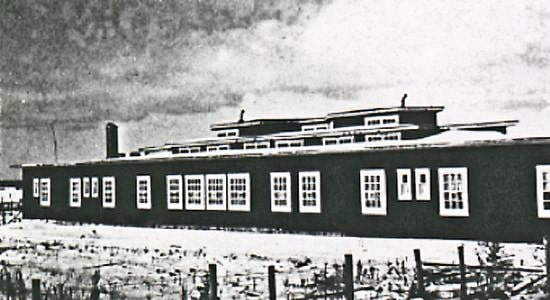 It was around 1926 that the first hospital was built at Ile-a-la-Crosse. At first it was difficult to keep doctors there, but finally, Dr Lavoie came who stayed for twenty years, covering a huge territory. Then a second, Dr Hoffman, was found who stayed in the North too. Now the old hospital has been torn down and a new one put up in its place. Similarly, the old church was demolished a few years ago, and a new one replaced it. The going of that old church caused a lot of grief among the old-timers who had helped to build it. All the lumber in it had been sawed by hand, and it was held together by square nails. The up-to-date church is just one of the many changes that have come to the North since I first knew it fifty years and more ago.
It was around 1926 that the first hospital was built at Ile-a-la-Crosse. At first it was difficult to keep doctors there, but finally, Dr Lavoie came who stayed for twenty years, covering a huge territory. Then a second, Dr Hoffman, was found who stayed in the North too. Now the old hospital has been torn down and a new one put up in its place. Similarly, the old church was demolished a few years ago, and a new one replaced it. The going of that old church caused a lot of grief among the old-timers who had helped to build it. All the lumber in it had been sawed by hand, and it was held together by square nails. The up-to-date church is just one of the many changes that have come to the North since I first knew it fifty years and more ago.
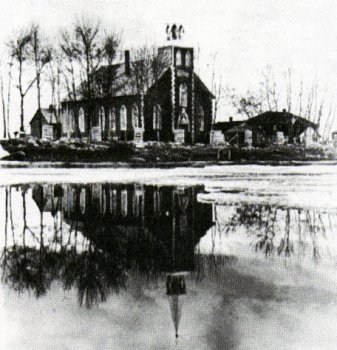 After the influenza epidemic that decimated the Chipewyan tribes' many white men came into the North, for fur was then a fair price and there was plenty of room for new trappers. Some came from Lac La Ronge and went into the Wollaston Lake country, or anywhere else that was not at the time being trapped. Many Indians, excellent canoe and portage men, came in as well. Most of the white men went upriver into Cree Lake or even stopped on the river itself. There were a few, too, on the Churchill. Others went further north in search of the caribou.
After the influenza epidemic that decimated the Chipewyan tribes' many white men came into the North, for fur was then a fair price and there was plenty of room for new trappers. Some came from Lac La Ronge and went into the Wollaston Lake country, or anywhere else that was not at the time being trapped. Many Indians, excellent canoe and portage men, came in as well. Most of the white men went upriver into Cree Lake or even stopped on the river itself. There were a few, too, on the Churchill. Others went further north in search of the caribou.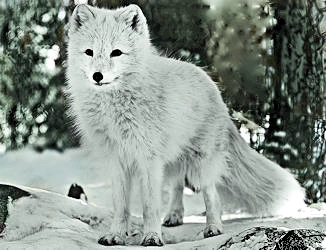 Every fall they meet on Lake Athabasca and go on to the Arctic Ocean to trap white fox.
With no new white men allowed to set up trapping and with some leaving and others dying, there began to be fewer and fewer to meet in Prince Albert as time went by. I knew three brothers, all younger than myself, who used to fish on Cree Lake. Though they lived an easier life than mine, they are all gone now. There used to be many white men who would take their canoes as far up some river leading out of the Churchill as they could go one summer, then return the next summer and try to penetrate farther north. Quite a number of these men trapped white fox in the barren lands. In that country, there are lots of logs along the rivers that can be used to make cabins.
Every fall they meet on Lake Athabasca and go on to the Arctic Ocean to trap white fox.
With no new white men allowed to set up trapping and with some leaving and others dying, there began to be fewer and fewer to meet in Prince Albert as time went by. I knew three brothers, all younger than myself, who used to fish on Cree Lake. Though they lived an easier life than mine, they are all gone now. There used to be many white men who would take their canoes as far up some river leading out of the Churchill as they could go one summer, then return the next summer and try to penetrate farther north. Quite a number of these men trapped white fox in the barren lands. In that country, there are lots of logs along the rivers that can be used to make cabins.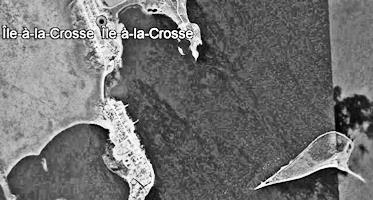 Although some white men worked well as partners in the North, most of them seemed unable to get along together and that is why there were so many lone trappers in those days. There was an island at Ile-a-la-Crosse called Big Island (right in the photograph), where many used to camp. There was no wood for fuel nearby, but they got the Hudson's Bay Company to haul in two loads for them, and they put up quite a little village of tents there in the wintertime. These men had a lot of horses. My partner and I often travelled north in their company. Many of them went up the Mudjatik River where some of them trapped. Others went up a small river and over some portages to Birch Lake, trying to get off the main route so they wouldn't be bothered with other trappers. Some went to Cree Lake, others down the Cree River and to Stoney Rapids where they could get supplies. The white fox trappers used to come there from the barren land. Still, others went down the MacKenzie River and onto Great Bear Lake, and some off on smaller rivers to build their camps. By being in the bush and trying different ways of trapping, we all learned a lot about the habits of fur-bearing animals.
Although some white men worked well as partners in the North, most of them seemed unable to get along together and that is why there were so many lone trappers in those days. There was an island at Ile-a-la-Crosse called Big Island (right in the photograph), where many used to camp. There was no wood for fuel nearby, but they got the Hudson's Bay Company to haul in two loads for them, and they put up quite a little village of tents there in the wintertime. These men had a lot of horses. My partner and I often travelled north in their company. Many of them went up the Mudjatik River where some of them trapped. Others went up a small river and over some portages to Birch Lake, trying to get off the main route so they wouldn't be bothered with other trappers. Some went to Cree Lake, others down the Cree River and to Stoney Rapids where they could get supplies. The white fox trappers used to come there from the barren land. Still, others went down the MacKenzie River and onto Great Bear Lake, and some off on smaller rivers to build their camps. By being in the bush and trying different ways of trapping, we all learned a lot about the habits of fur-bearing animals.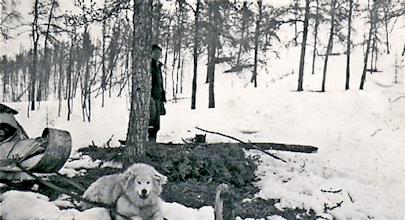 For many trappers, solitary life did not work out well. There are not too many men that can stand a whole winter alone in that bleak country. The winters are too long, and most of them can't endure the seemingly endless, quiet nights. I doubt if a third of those who tried to go it alone lasted until old age took them, and many suffered terribly. I know of one that finally got so scared in his lonely camp that he started out running - maybe from something he imagined he heard? - and was never seen again. I knew another loner that died of scurvy in his camp. Two years later another man who stayed in that same cabin suffered the same fate. There is no danger of getting scurvy, though, even though you live on a continual diet of meat and fish, providing you avoid salt. I lived on such a diet for twenty-five winters and suffered no ill effects. A man who eats fresh, unsalted meat will not get scurvy.
For many trappers, solitary life did not work out well. There are not too many men that can stand a whole winter alone in that bleak country. The winters are too long, and most of them can't endure the seemingly endless, quiet nights. I doubt if a third of those who tried to go it alone lasted until old age took them, and many suffered terribly. I know of one that finally got so scared in his lonely camp that he started out running - maybe from something he imagined he heard? - and was never seen again. I knew another loner that died of scurvy in his camp. Two years later another man who stayed in that same cabin suffered the same fate. There is no danger of getting scurvy, though, even though you live on a continual diet of meat and fish, providing you avoid salt. I lived on such a diet for twenty-five winters and suffered no ill effects. A man who eats fresh, unsalted meat will not get scurvy.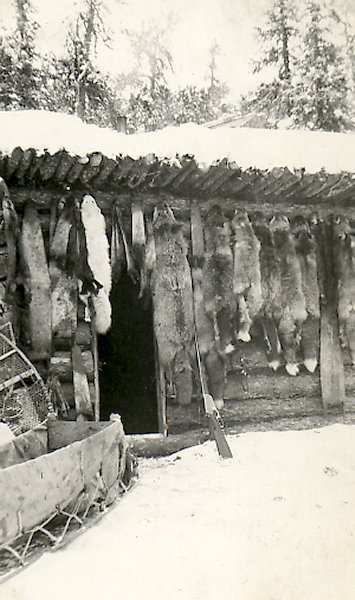 and were experienced men that were successful in the life they had chosen. While some moved farther north and some went prospecting, most of them stayed in the North once they had come there. Some brought along their wives and made a good life for themselves, fishing and trapping. Others married native women. Then along came the great depression. A lot of men who had lost their normal livelihood in the South came in with poor outfits and no idea of how to live in the North. Some of these lost their outfits in rapids. Some froze their feet in the slush on the lakes. Some threw in their lot with the local fishermen. Not many stayed with the trapping, and when times picked up most of them went back south again.
To the best of my knowledge, Only two of the old white trappers of my day are now left in my part of the North - my old partner, Fred Darbyshire, and another man who lives on Foster Lake. Both of them are well into their seventies, and old age will soon force them to leave the life they love.
I have said a lot about solitary trappers who got into difficulties trying to live by themselves. While you never saw a solitary Indian in the North, many white men tried to make it on their own, and some of them got along pretty well. A man has the right to choose his own style of life. After the first few years, I decided that I could do better on my own than with a partner because I would be free to go and come as I wished. When I left camp, I would be free to stay away two weeks or a month and there would be nobody to worry or to be inconvenienced.
I learned early that the only way to live as a trapper in the North was to have a cabin where I could keep my supplies dry and fix up my furs. I would leave my cabin on Russell Lake and head north up a river that we called Beeds River, along a trapline that I travelled nearly every winter for twenty years. The last ten of those years I pampered myself by having a tent and a stove instead of sleeping in the open. I had four dogs and a toboggan, and I had enough traps that I could leave some on the trapline from year to year. No one ever bothered a man's unguarded traps. Vandalism and thievery were unknown at that time in the North (if you except the occasional curious bear). Indeed they appeared only with outsiders who were flown into the country on vacation jaunts.
and were experienced men that were successful in the life they had chosen. While some moved farther north and some went prospecting, most of them stayed in the North once they had come there. Some brought along their wives and made a good life for themselves, fishing and trapping. Others married native women. Then along came the great depression. A lot of men who had lost their normal livelihood in the South came in with poor outfits and no idea of how to live in the North. Some of these lost their outfits in rapids. Some froze their feet in the slush on the lakes. Some threw in their lot with the local fishermen. Not many stayed with the trapping, and when times picked up most of them went back south again.
To the best of my knowledge, Only two of the old white trappers of my day are now left in my part of the North - my old partner, Fred Darbyshire, and another man who lives on Foster Lake. Both of them are well into their seventies, and old age will soon force them to leave the life they love.
I have said a lot about solitary trappers who got into difficulties trying to live by themselves. While you never saw a solitary Indian in the North, many white men tried to make it on their own, and some of them got along pretty well. A man has the right to choose his own style of life. After the first few years, I decided that I could do better on my own than with a partner because I would be free to go and come as I wished. When I left camp, I would be free to stay away two weeks or a month and there would be nobody to worry or to be inconvenienced.
I learned early that the only way to live as a trapper in the North was to have a cabin where I could keep my supplies dry and fix up my furs. I would leave my cabin on Russell Lake and head north up a river that we called Beeds River, along a trapline that I travelled nearly every winter for twenty years. The last ten of those years I pampered myself by having a tent and a stove instead of sleeping in the open. I had four dogs and a toboggan, and I had enough traps that I could leave some on the trapline from year to year. No one ever bothered a man's unguarded traps. Vandalism and thievery were unknown at that time in the North (if you except the occasional curious bear). Indeed they appeared only with outsiders who were flown into the country on vacation jaunts.